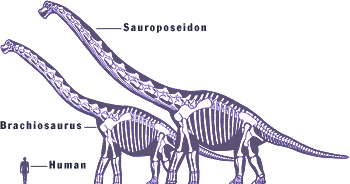
According to Oklahoma paleontologist Richard Cifelli, researchers from the University of Oklahoma have uncovered the largest remains of dinosaurs as of yet. The official research paper on the supergiant will be presented in the March issue of the Journal of Vertebrate Paleontology, but Cifelli has already named the dinosaur Sauroposeidon, or "earthquake God lizard."

Cifelli led a team that uncovered the bones in southeastern Oklahoma in 1994. When he first uncovered them, Cifelli believed they were the remains of the trunks of prehistoric trees. Upon closer examination, he realized that they represented neck bones (about 4 feet long each!) and belonged to a large dinosaur, but literally packed the bones away until a graduate student needed a research thesis to work on.

In the process of the thesis the graduate student recognized that the new creature was a relatived of the famed Brachiosaurus, another famed supergiant that can be seen mounted in such famous institutions as Chicago's Field Museum. Brachiosaurus itself could stretch its head up approximately 13.5 meters (or 45 feet), but team member Matthew Wedel disclosed that, "the neck on our creature is about a third longer than that of Brachiosaurus, and, according to Cifelli, stood 18.3 meters, or an astounding 60 feet, tall and weighed nearly 60 tons. As any dinosaur fan can attest, this is truly a massive dinosaur!

Cifelli, Wedel, and the Oklahoma team then proceeded to CAT scan the amazingly large bones at the university's hospital and were surprised to find tiny air cells inside the bone. According to Cifelli, these air cells made the neck lighter and easier to lift. "No matter how small the dinosaur's brain was, just lifting it up was a challenge. It's remarkable how large the bones are," he told the press the day after his findings were announced. "It would be very hard to imagine that a neck could get much longer and still function," he added."
Cifelli also remarked that Sauroposeidon may have been the "last of its kind." "He's an old design. By this time, that body plan is just not working anymore. By the time this guy comes along, they are dying out in North America. He is pretty much the last of his kind." Sauroposeidon lived about 110 million years ago and probably inhabited a swampy river delta. According to British news reports, "The Gulf of Mexico had swamped most of Texas, bringing the shoreline to Oklahoma."
Once again, the official research paper will be presented in the Journal of Vertebrate Paleontology in March, so until then, please check out these web stories on the amazing Sauroposeidon:
 SAUROPOSEIDON LINKS PAGE (MANY MORE RELATED WEBPAGES)
SAUROPOSEIDON LINKS PAGE (MANY MORE RELATED WEBPAGES)
 Complete Index of Dino Land's Dinosaur/Paleontology News Articles
Complete Index of Dino Land's Dinosaur/Paleontology News Articles
© 1997 brusatte@theramp.net